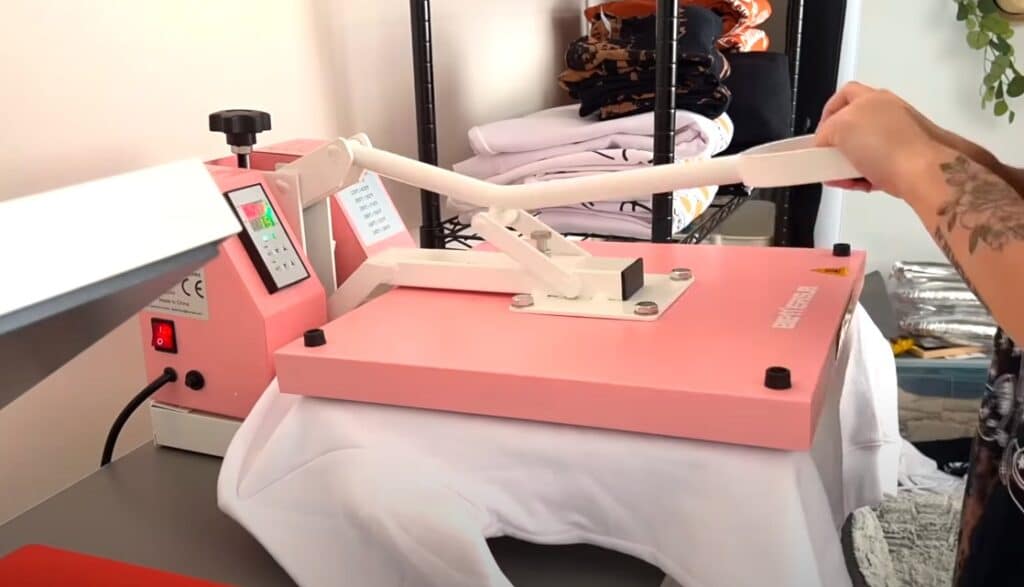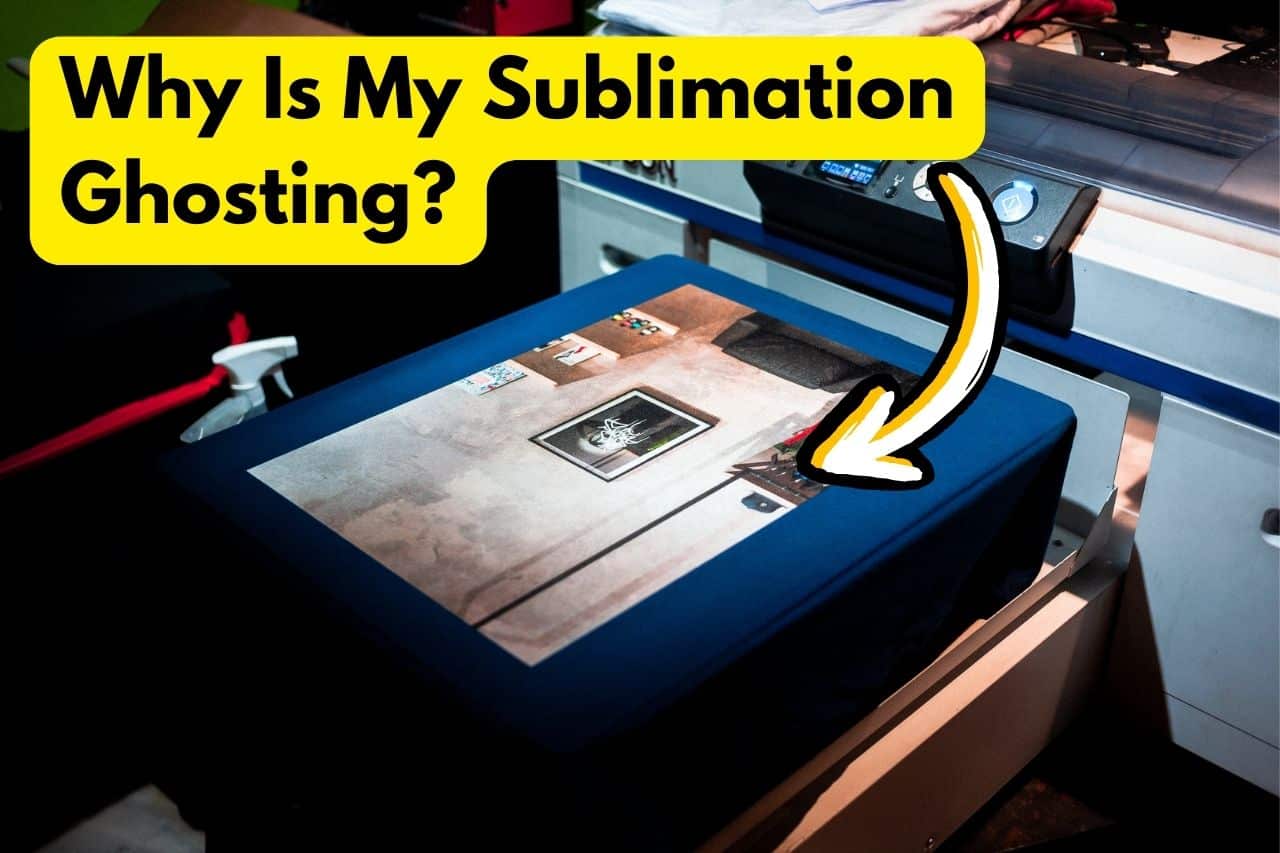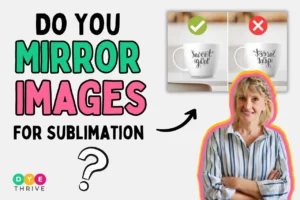Ever create a beautiful mug or shirt only to find a faint, ghostly copy lingering on top? Don’t despair!
Sublimation ghosting happens to even the best of us, but it’s nothing a little fix can’t solve.

Imagine painting a masterpiece on a mug, only to find a blurry copy peeking through. That’s ghosting! It happens when your design “shifts” during the heating process, leaving a faint echo.
But Wait, There’s Hope!
This guide will be your ghost-busting buddy, explaining:
- Why ghosting happens (like a detective!)
- Simple tricks to prevent it (no science degree needed!)
- Easy fixes if it already happened (we got you covered!)
So, grab your favorite mug (hopefully not ghosted!), put on your reading glasses if needed, and let’s banish those pesky shadows together!
Also Read:
Are Sublimation Mugs Microwave Safe? (Yes, They Are But..)
Why is Black Sublimation Turning Green? (Explained)
Are Sublimation Plates Food Safe? (Explained!!)
What Is Sublimation Ghosting?
Let’s start by understanding exactly what sublimation ghosting refers to.
Sublimation ghosting is when a duplicate, faded imprint of your design appears slightly above or next to the primary image on a sublimated product like a t-shirt, ceramic tile, or stainless steel tumbler.

In simpler words, ghosting means you get a faded, blurry copy of your printed design hovering over the main image. It’s like the ink didn’t fully stick in place during pressing.
This ghosting can show up in a few ways:
- A faint outline duplicating any text you printed
- A blurred double border around a graphic shape
- A lighter shadow version next to the main image
Basically there’s two prints – the bold one you wanted and a paler ghost twin!
How you notice ghosting varies a lot. From a barely there whisper to full supernatural apparition levels!
Smooth fabrics like polyester tees make it easier for that transfer paper to shift during pressing. So you’re more likely to spy ghosts on them. They really show up around dark inks like black or navy blue.
With bumpier mugs, you might just catch a faint glow around the mug print.
But in all cases, ghosting makes your prints look lower quality. As the maker, it can be super frustrating to deal with!
When deciding if your print is ghosted or just looks that way due to the material texture, here’s a good check – real ghosting blurs the actual design lines, while a textured surface alone won’t distort the crispness of the print.
Now let’s get into some detective work on why this happens and how to catch those sneaky specters!
Why Is My Sublimation Ghosting?
Ghosting arises from factors that make the transfer paper slip and shift against the substrate during the high heat and pressure of the sublimation process.
Understanding the root cause is key to troubleshooting and prevention.
Here are 5 common culprits behind sublimation ghosting and DIY solutions to address them:
1. Minute Shifting of the Image During Pressing
It’s incredibly easy for lightweight, slippery fabrics like polyester shirts and satin jackets to shift imperceptibly when closing your heat press for sublimation.
Even minute disturbance between the layered transfer paper and substrate creates duplicate markings from the still-hot inks. This manifests as ghosting on the finished product.

Solution: Secure the transfer print firmly in place before pressing using either:
– Heat transfer tape around all four edges
– Temporary adhesive spray like Thermo Web’s Deco Foil Spray
– Non-stick interface material like Teflon sheets with inherent grip
This helps avoid movement when the pressure hits, letting sublimation happen cleanly without distortion.
2. Lifting the Press Too Quickly Post-Sublimation
Here’s an interesting heat transfer science tidbit – aggressively separating your heat press platen from the printed product can actually generate suction between the two surfaces.

So if you rip that mug or coaster directly upwards after pressing, the rapid vacuum pulling action lifts your transfer up momentarily before it flops back onto the substrate.
This secondary impact often leaves a faint ghost image behind even if the initial sublimation seemed flawless right after completion.
Solution: Gently peel back the press once dwell time is done. Give the vacuum seal between platen and paper a chance to release slowly as you steadily open the clamp. No abrupt lifting motions.
Also, wait 5-10 seconds before removing the transfer sheet so residual heat helps it detach cleanly from the fabric.
No suction = No ghosting.
3. Shrinkage of the Fabric
Ever pulled a shirt out of the dryer and it’s tighter than before? That’s shrinkage happening!
The heat makes the fabric shrink and change size. And shrinkage during pressing also causes ghosting issues.
When you press polyester fabrics without pre-treating first, that high heat makes the material shrink and twist.
But the transfer print stays the same size! So you get a mismatch with blurring and double markings around the shrunken shirt fibers.
So the key is to pre-shrink the fabric first before pressing your print!
Pretreat the Shirt
Wash and dry the polyester shirt on highest heat it will face regularly later.
This tightens all fibers so it won’t shrink more during sublimation, messing up your print!
For fragile banners and inflatables that can’t handle washing, use a heat gun first to gently stretch and stabilize the material beforehand.
Pre-treating makes the fabric shrinkage match the print during sublimation. No more distortion or ghost copies!
Let me know if the explanation needs clarification or expansion!
4. Failure to Adhere Paper to The Substrate
When transferring images onto low-texture fabrics like satin jackets or table linens, there’s a high risk of the transfer paper slipping if not firmly fixed in place.
Why?
Because smooth, lightweight materials provide minimal inherent grip to immobilize the layered transfer sheet against horizontal movement.
So without solid bonding between paper and product pre-pressing, you invite opportunities for distortion and marking inconsistencies – both causes of ghosting.
Solution: Use either heat transfer tape or adhesive spray to form a tight seal between the transfer sheet and substrate before pressing.

Heat-resistant adhesive sheets like Thermo Tape create secure edge bonding that prevents the paper from slipping out of place when the heat/pressure hits.

Alternatively, temporary spray adhesives like ThermOtec leave a tacky residue on the fabric allowing the transfer to stick firmly. Once again negating movement potential and thereby ghosting.
Both tape and spray introduce reliable sticking action between layers WITHOUT leaving messy residues post-peel.
5. Incorrect Time and Temperature Settings
A common newbie sublimation mistake – incorrectly calibrated pressure settings lead to faded, incomplete ink transfer.
When your temp is too low or dwell time too short, the sublimation reaction won’t occur optimally. Resulting in washed-out or double images typical of ghosting.

Conversely, excessively high temperatures scorch lighter fabrics like pastel shirts. And extended dwell periods overbake transfers charring the dyes and fabric.
In both cases, you risk ending up with distorted, phantomic prints.
Solution: Dial in the right temperature and dwell duration for sublimation.
- Refer to ink and substrate guidelines for ballpark settings
- Vary heating intensity based on color density (lower for darker colors)
- Perform test presses on scrap material to determine ideal calibration
Accounting for the unique properties of YOUR materials and inks is key for pixel-perfect sublimation without blurriness or ghosting.
Why Is My Sublimation Tumbler Ghosting?
Tumblers and mugs bring additional scope for ghosting over single-layer flat substrates like t-shirts due to their 3D shape.

Ghosting typically occurs around:
Lid and handle edges with abrupt changes in surface contour
Bottom exterior/interior which faces directly against heating elements
Any sharply curved areas like the rim or base of stainless steel cups
When customizing drinkware, ghosting can arise due to:
- Uneven wrapping around complex geometries causes air gaps and uneven ink transfer
- Excessive pressure against rigid materials like stainless steel and ceramics
- Overheating tiny imprint sections like mug bottoms and lid interiors
- Heat tape residue interfering with sublimation action on printed zones
To minimize ghosting on sublimated tumblers and mugs:
- Wrap it perfectly over all the rounds and corners. No gaps or wrinkles! Complete contact means no ghosting.
- Don’t press down too hard on hard steel or ceramic mugs! That risks the paper moving against the slippery surface. Go lighter on the pressure so your wrap stays put.
- The bottom and edges by the lid heat up really fast. Lower the temperature or time a bit there to avoid scorching.
- Only use heat tape on parts you won’t print. Test on a small patch first to check it doesn’t leave a sticky residue.
Getting the wraps flawless plus figuring the right settings for every spot takes practice. But you’ll be making ghost-free tumblers in no time!
Pro-Tip: Use non-adhesive interfacing fabrics like Teflon sheet or reusable release paper to minimize ghosting on challenging cylindrical or conical tumbler regions.
FAQs Why Is My Sublimation Ghosting
Here are some common frequently asked questions on the topic “Why Is My Sublimation Ghosting” .
How do I stop ghosting on shirts and prints?
Make sure to fully secure the transfer paper so it cannot shift around when your design is being pressed onto the shirt or tumbler.
Slowly lift your heat press up at an even pace too – no sudden ripping movements that might distort the print!
And scrubbing that poly fabric well beforehand never hurts either as pre-washing helps avoid annoying shrinkage issues down the road.
How do I prevent ghosting on tumblers?
For tumblers, carefully smooth wrinkle-free contact over all the curved grooves and 3D contours when wrapping.
Don’t press too forcefully on tough materials like steel where shifting can happen.
Consider lowering time/temp slightly around lids and bases where scorching risks occur.
And test old heat tape first on an ignored patch to ensure no residue will lift during peeling before applying willy-nilly over print zones.
Why did my print come out faded?
If your print comes out faded, chances are either time or temp settings weren’t right for complete ink transfer.
Or the transfer paper itself had inadequate ink density.
Sun exposure pre-press and harsh detergents post-print can slowly strip away vibrancy too over time.
Wrapping up
Now you know what makes those ghost print marks appear. Things like the paper shifting during pressing or the fabric shrinking under heat.
Luckily once you pinpoint the cause, you can troubleshoot it!
- Try adjusting the heat press temperature dial or time settings
- Improve how you prep and secure the fabric
- Or modify your technique getting the transfer paper perfectly in place
It may take some playing around to get it right. But with patience, care, and pressing a few test pieces to practice, you’ll crack the ghosting code!




